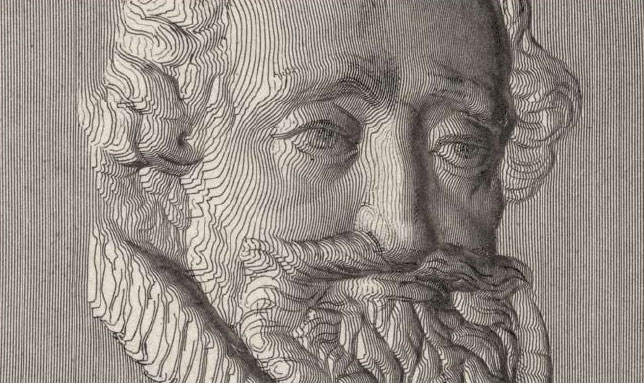- Relief printing
- Intaglio and planographic printing
- Color printing
- Bits and pieces
- Early photography in silver
- Non-silver processes
- Modern photography
- Color notes
- Color photography
- Photography in ink: relief and intaglio printing
- Photography in ink: planographic printing
- Digital processes
- Where do we go from here?
Pantograph etchings

Pantographically derived etching. Artist unknown. The Head of Henry IV. n.d. Relief medallion. 1837. 3 3/4 x 3 3/4" (9.5 x 9.5 cm). Printed by Achille Colas. From “Answer to Mr. Bate’s Challenge,” Literary Gazette no. 1047 (London), February 11, 1837. The Museum of Modern Art, New York. Gift of Richard Benson.
The nineteenth century was the age of commemorative relief medals. They were made to honor notable occasions and famous people, and were cast in multiple copies of great precision and beauty. I came across a book of extraordinary etchings made from these medals, and include one here because the etched printing plates were generated mechanically from the medal’s relief modulations. The work was done with a pantograph, a mechanical device that uses a series of bars on pivots to trace forms and produce analogs of them in different sizes. Pantographs were used in silhouette-making, and to reduce or enlarge drawings and sculptural work. In this particular case the pantograph was asked to translate the vertical modulations of the medal’s surface into variously spaced lines scored in an etching ground. One end of the pantograph ran over the medal and was constrained to run in a straight line only.

Detail of Pantographically derived etching. Artist unknown. The Head of Henry IV. n.d. Relief medallion. 1837. 3 3/4 x 3 3/4" (9.5 x 9.5 cm). Printed by Achille Colas. From “Answer to Mr. Bate’s Challenge,” Literary Gazette no. 1047 (London), February 11, 1837. The Museum of Modern Art, New York. Gift of Richard Benson.
In the background of the print, showing the flat part of the medal, vertical, close, evenly spaced parallel lines produced the effect of an even tone. When the operator raised the tracing stylus by moving it over the relief section of the medal, the line being drawn in the etching ground by the other end of the pantograph was shifted slightly to the right (actually to the left, because the print is reversed). By running the stylus repeatedly across the medal’s surface, and shifting each line minutely forward from the one before, the printer drew a topographical map of the medal on the prepared plate surface. Once etched, this plate could be inked, wiped, and printed to produce the picture we see here. It is a remarkable process, and only understandable by looking at highly magnified sections. The changing spacing between the lines causes a lightening in areas that rise up on the left of the print; as the form begins to fall off on the right side, the line spacing is reduced and the tone darkens. The increasing and diminishing of the line spaces is perfect, so that the flat surround retains its even gray tone even while the lightening of the head on one side is perfectly compensated for by a darkening on the other. The viewer’s impression is that the medal has been lit from the left side—an apparently perfect lighting, coming not from one point but from parallel rays skating at a low angle across the surface of the medal.

